How To Get A Flat Tummy In A Month
Perfection takes time; in this case you need just 30 days to get a perfectly toned belly.

Image: ShutterStock
It is difficult to get rid of belly fat. Excess belly fat increases the risk of type 2 diabetes, heart disease, and hypertension (1), (2), (3). That’s exactly why you need to know how to get a flat stomach within a month! Yes, give yourself 4 weeks to get rid of the abdominal fat that is more dangerous than thigh fat in women (4), (5). Take charge and practice these 15 proven ways to get a flat tummy. Scroll down!
Note: Weight loss depends on your age, sex, current weight, genetics, medical history, and adherence to the plan (6).
In This Article
What To Do To Get A Flat Tummy In A Month
1. Reduce Your Calorie Intake

Reducing the calorie intake helps shift your body to the weight loss mode. Scientists have found that reducing calories can help men and women lose weight fast (7).
However, you must lower your calorie intake gradually. Give your body time to adjust. Cut down 500 calories in the first week. If you consume 2200 calories now, consume 1700 calories in the first week. Reduce 500 calories more in the second week and bring it down to 1200 calories. Be on the 800-calorie diet (a very low-calorie diet or VLCD) in the last two weeks (8).
Don’t get alarmed! Scroll down to find out how to reduce calorie intake easily.
2. Avoid Sugary Foods
Avoid sugary foods like sugar cubes, cakes, pastry, bagel, sauces, ketchup, bottled salad dressings, granola bars, candies, milk and white chocolate, pasta, bread, white flour, soda, packaged fruit juices, syrups, flavored teas, flavored yogurt, and sugar-free foods.
Practicing healthy eating habits and cutting down on sugary foods will help reduce calorie intake and the risk of cardiovascular disease, hypertension, type 2 diabetes, sleep-disordered breathing, ADHDi A neurodevelopmental disorder that affects focus and self-control and is characterized by impulsivity, hyperactivity, and inattention. , and cancer (9), (10).
3. Increase Fiber Intake
Foods rich in dietary fiber are great for quick weight loss (11). They are also known as “complex carbs.” They form a gel-like layer in the stomach, thereby increasing digestion time. This, in turn, increases satiety (12). They help improve digestion by increasing the number and variety of good gut bacteria (13).
Dietary fiber also improves bowel transition through the colon and prevents constipation and toxin accumulation. Here’s what you can consume:
- Veggies – Carrot, cauliflower, Chinese cabbage, cabbage, bok choy, spinach, chard, kale, radish greens, parsley, scallions, okra, eggplant, edamame, peas, bottle gourd, bitter gourd, ridge gourd, beetroot, cucumber, tomato, lettuce, and cilantro.
- Fruits – Apple, banana, peach, pear, orange, sapodilla, prune, pomegranate, blueberry, strawberry, mulberry, guava, plum, watermelon, muskmelon, grapefruit, sweet lime, lime, and lemon.
- Grains And Pseudograins – Brown rice, red rice, black rice, sorghum, barley, broken wheat, amaranth, quinoa, and oats.
- Seeds – Chia seeds, ground flaxseeds, melon seeds, cucumber seeds, and pumpkin seeds. Here is a list of high fiber foods for weight loss.
4. Consume More Protein
Scientists found that a high-protein diet led to greater weight loss, increased metabolism, satiety and fat oxidation, reduced waist circumference, and improved lean muscle mass (14), (15), (16). Here’s a list of lean protein sources. Consume at least one source of protein with each meal:
- Plant sources of lean protein – Kidney beans, fava beans, soya beans, edamame, lentils, garbanzo beans, mushroom, tofu, seeds, and nuts.
- Animal sources of lean protein – Egg, milk, ground turkey, skinless chicken breast, mackerel, salmon, tuna, haddock, herring, basa, carp, yogurt, homemade ricotta cheese without sugar, and casein water.
In addition to these, you may also consume protein shakes for a flat tummy. A clinical study published in the BMC Journal of Nutrition and Metabolism found that individuals consuming a whey protein drink before a meal lost more body fat than the control group. Also, they lost significantly less lean muscle mass as compared to the other group (17).
You can buy protein shakes online. But if you are looking to go natural, make your own protein shake at home with fiber and protein-rich ingredients such as tofu, whey, oats, quinoa, peanuts, pistachios, cottage cheese, Greek yogurt, or soy milk.
5. Stay Hydrated

Hydration is key to maintaining a healthy weight. A study published in the journal Nutrients states that increased water consumption leads to reduced body weight, waist circumference, and body fat mass (18).
Another scientific review states that water intake increases metabolic rate (19). American scientists found that inadequate water intake is directly associated with higher BMI or, in other words, higher chances of being obese (20).
Drink 3-4 liters of water per day. You may also consume water through fresh fruit and vegetable juices and soups. However, be careful not to drink too much water, as it may cause water intoxication.
6. Consume Omega-3
Omega-3 fatty acids are healthy fats that help reduce inflammation (21). Foods rich in omega-3 fatty acids balance the omega-3 and omega-6 ratio, which should ideally be 1:1. But poor diet choices lead to higher omega-6 consumption, causing the ratio to shift to 1:20 (22). This increases the risk of inflammation-induced obesity. Here’s a list of omega-3 fatty acid-rich foods to include in your diet.
Omega-3 foods:
- Fatty fish, like silver carp, salmon, sardine, mackerel, hilsa, tuna, and cutla.
- Healthy oils, like olive oil, avocado oil, and flaxseed oil.
- Nuts and seeds, like almond, flax seeds, chia seeds, pistachios, and walnuts.
- Supplements, like fish oil supplements (consult a doctor for dose and frequency before consuming).
7. Consume Green Tea
Green tea is a natural weight loss beverage. It is loaded with antioxidants known as catechinsi Compounds in tea that are high in antioxidants and are proven to enhance heart health and metabolism. (EGCG, EGC, and ECG).
Japanese scientists found that consuming green tea catechins for 12 weeks helped reduce waist circumference, body weight, BMI, and blood pressure (23).
Another study shows that green tea EGCG suppresses the genes involved in fat and triglyceride synthesis and increases fat breakdown (24). You can prepare green tea and consume 2-3 cups of it daily. Consume decaf green tea if you are caffeine sensitive.
8. Consume Probiotics

Probiotics are non-pathogenic or good bacteria found in fermented foods like kimchi and yogurt. These microorganisms improve digestion, boost immunity, and reduce cholesterol and blood pressure (25).
Scientists believe that probiotics increase energy utilization, insulin sensitivity, and satiety (26). Consume half a cup of full-fat yogurt or 8 ounces of buttermilk (without salt), and 1 small bottle of probiotic drink per day. Avoid kimchi and pickles.
9. Avoid High-Sodium Foods
Sodium is an essential nutrient. But consuming too much sodium from food sources can cause water retention, cardiovascular diseases, and high blood pressure (27). The CDC recommends consuming less than 2300 mg of sodium per day (28).
If you want to lose belly fat, you must give up on high-sodium foods like fries, pizza, fried chicken, frozen foods, biscuit, sausage, salami, bacon, canned soup, bottled sauces, ketchup, pickles, and kimchi.
10. Snack Healthy
Follow healthy snack habits. Consume carrot, cucumber, tomato, watermelon, banana, apple, muskmelon, pistachios, melon seeds, pepita, berries, coconut water, freshly-pressed juices without sugar and salt, khakra, dhokla, thepla, and other snacks under 100 calories. Drink 8 ounces of water after you snack.
 Quick Tip
Quick Tip11. Try Intermittent Fasting
Intermittent fasting is a great way to push your body to the calorie-burning mode (29), (30). All you have to do is fast for a few hours and then eat whatever you want. It is a great plan for people trying to lose belly fat quickly. If you are not sure how to start, here’s a comprehensive guide to intermittent fasting.
A survey conducted among 1,200 US healthy adults found that 87% of Americans have tried intermittent fasting. Around 50% of them found this diet very effective and 37% of them also found it somewhat effective. It was also found that 87% of the people on this diet found it inexpensive.
 Fun Fact
Fun Fact12. Start Cardio

Cardio is a great full-body exercise that helps you burn fat and get a toned body. This fitness practice can stimulate weight loss up to 2 kgs (4.4 lb) and lower the risk of heart disease, stroke, type 2 diabetes, hypertension, and lung disease (31). Set aside 30-45 minutes every day to do the following exercises to lose belly fat:
- Warm-up – 10 minutes
- Brisk walk or jogging – 10 minutes (8 mph)
- Crunches – 3 sets of 8 reps
- Bicycle crunches – 3 sets of 8 reps
- Leg raises – 3 sets of 8 reps
- Burpees – 3 sets of 8 reps
- Leg in and outs – 3 sets of 8 reps
- Russian twist – 3 sets of 8 reps
- Scissor kicks – 3 sets of 8 reps
- Mountain climbers – 3 sets of 10 reps
- Spider climbers – 3 sets of 10 reps
- Elbow plank – 2 sets of 30 seconds hold
- Cool off stretches – 5 minutes
You may also take a look at exercises for reducing belly fat. Incorporating these into your routine may also help get you a flat tummy.
13. Do HIIT And Resistance Training
HIIT (high-intensity interval training) and resistance training can help you lose belly fat (32), (33). HIIT induces EPOC (Excess Postexercise Oxygen Consumption), which means that you will burn fat even after 2 hours of exercising (34).
Scientists have found that HIIT aids 28.5% greater weight loss than moderate-intensity workouts (35). Resistance training, on the other hand, prevents muscle loss and helps build lean muscle (36), (37). Do the following HIIT and resistance exercises to engage your abdominal muscles and reduce belly fat:
HIIT
- Sprints
- High-intensity rope jumps
- Jump squats
- Jump lunges
- Box jumps
- High knees
Resistance Workouts
- Resistance band crunches
- Resistance band leg lifts
- Resistance band bicycle crunches
- TRX knee tucks
14. Keep The Stress Away
Stress and worry increase cortisoli A hormone that regulates the body's stress response, metabolism, and inflammation and affects several body functions. levels in the body. This, in turn, causes fat accumulation in the belly region (38), (39). Try meditating, drawing, painting, dancing, traveling, and learning a new skill to reduce stress and release the “happy hormones.” You can also talk to a licensed therapist.
Eman, a blogger, talks about how she started her weight loss journey to get a flat tummy, as well as the challenges she faced and how she overcame them. She adds that stress and emotional eating contributed to some of her weight gain. She writes, “I was definitely an emotional eater. I would eat when I was bored or sad. I ate somewhat healthy food. I just ate a lot of it (i).”
15. Sleep Well

Sleep is crucial to maintain metabolic homeostasisi The body's ability to maintain the balance of energy and nutrients for optimal function. (40). Disturbed sleep causes obesity, and vice versa (41). Sleep deprivation increases hunger, insulin resistance, and the chances of visceral or abdominal fat accumulation (42), (43).
Get at least 7 hours of sound sleep every night. Switch off all the lights as melatonin, a sleep hormone that is produced only in darkness, will promote better sleep (44).
The question is, how much belly fat will you lose in a month after doing the above? Find out in the next section.
Key Takeaways
- Excess belly fat can increase the risk of heart diseases, type 2 diabetes, and hypertension.
- You can get a flat tummy in a month by reducing your calorie intake, avoiding sugary foods, increasing your fiber intake, and practicing intermittent fasting.
- You may lose up to 12 pounds in a month by doing cardio, HIIT, and resistance training.
- Healthy lifestyle changes like managing stress through activities like meditation, running, drawing, etc., and getting about 7 to 9 hours of sleep regularly can further support your weight loss journey.
How Much Belly Fat Will You Lose In A Month?
You may lose up to 12 pounds (~6 kg) in a month. But you will lose overall body weight as well. If you want to lose belly fat, you must laser target the area with exercises (listed above). This can help reduce waist circumference, and your stomach will appear flatter than before.
Remember, your weight loss will depend on your adherence to the diet and exercise plan, height, weight, age, sex, medical history, and current medications. If you are onantidepressantsi Drugs that can lessen the symptoms of depression, anxiety disorders, chronic pain, and other mental health issues. , you will not lose belly fat fast. Talk to your doctor or a registered dietitian to know the best way to shed pounds from the tummy area.
Other Ways To Imitate A Flat Tummy In A Month
- Wear waist cinchers.
- Wear tops and dresses with vertical stripes.
- Wear mid to high-rise jeans.
- Wear peplum tops.
- Layer your clothes with well-tailored jackets and scarves.
- Wear shirt dresses with belts to create an hourglass shape.
- Wear confidence.
While some tried and tested generic ways can help you slim your midriff, incorporating personalized strategies based on your fitness and nutrition preferences will lead to more sustainable outcomes on your journey to a flat tummy. Scroll down to know more.
Personalized Advice For Different Fitness Levels & Goals
Fitness Level
- Beginners: Pay attention to hydration, balanced meals, and slow progress.
- Intermediate: Incorporate strength training, monitor progress, and optimize macronutrient intake.
- Advanced: Optimize performance-based nutrition, recovery techniques, and micronutrients.
Fitness Goal
- Weight Loss: Prioritize low-sugar beverages, high-protein meals, and calorie deficit.
- Muscle Gain: Prioritize strength exercise while increasing your intake of calories and protein.
Infographic: Simple Tips To Get A Flat Stomach In One Month
Getting rid of tummy fat can be difficult. However, numerous techniques can be used to both reduce body fat and get a slim waistline. The infographic below includes methods that could aid people in achieving a flat tummy. Take a look! Illustration: StyleCraze Design Team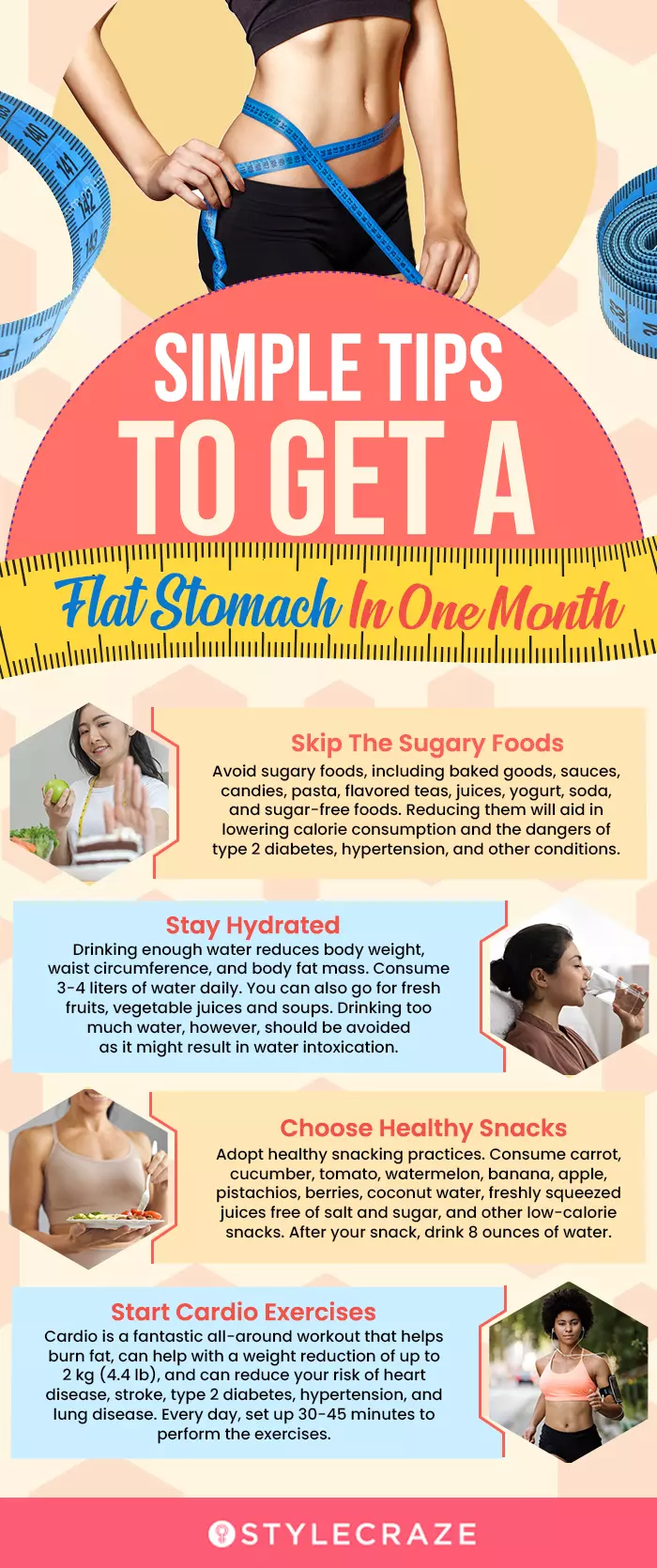
Belly fat is not only a cosmetological issue. It can also affect your overall health negatively. That is why many people want to know how to get a flat tummy in a month. Reducing calorie intake, avoiding sugary foods, increasing fiber intake, consuming more protein, getting adequate hydration, consuming omega-3 fatty acids and green tea, avoiding high sodium foods, doing cardio workouts and resistant training, and sleeping well are some effective ways to reduce belly fat. Eating a healthy diet and sticking to a strict exercise regimen will also help you meet your belly fat reduction goal.
Frequently Asked Questions
Is crash dieting safe to achieve a flat tummy?
No, it is not. Jordan Anthony, a registered dietitian nutritionist, says, “The key to achieving a flat tummy is a combination of fat burning and abdominal exercises. For most people, it will take well over a month to get there. Trying a crash diet is dangerous, and ultimately counterproductive.” She also stresses the importance of exercise and a balanced diet. Anthony adds, “Achieving and maintaining a flat tummy requires regular exercise with a focus on core work like sit-ups and squats as well as a diet that’s high in fiber and low in carbohydrates in order to encourage the body to burn fat for energy.”
Can I flatten my stomach in 3 days?
While any significant fat loss is not feasible in 3 days, you may get rid of bloating or lose some water weight in 3 days.
How can I get a flat stomach without exercise?
While lifestyle changes, the right diet, and nutrition play a role in avoiding bloating and fat buildup in the first place, a detox diet and drinks may also help make a difference. Medical procedures like liposuctioni A surgical procedure that targets specific body regions, such as the tummy, hips, or thighs, and removes fat using a suction technique. can help you get a flat stomach without exercise.
Illustration: How To Get A Flat Stomach In A Month
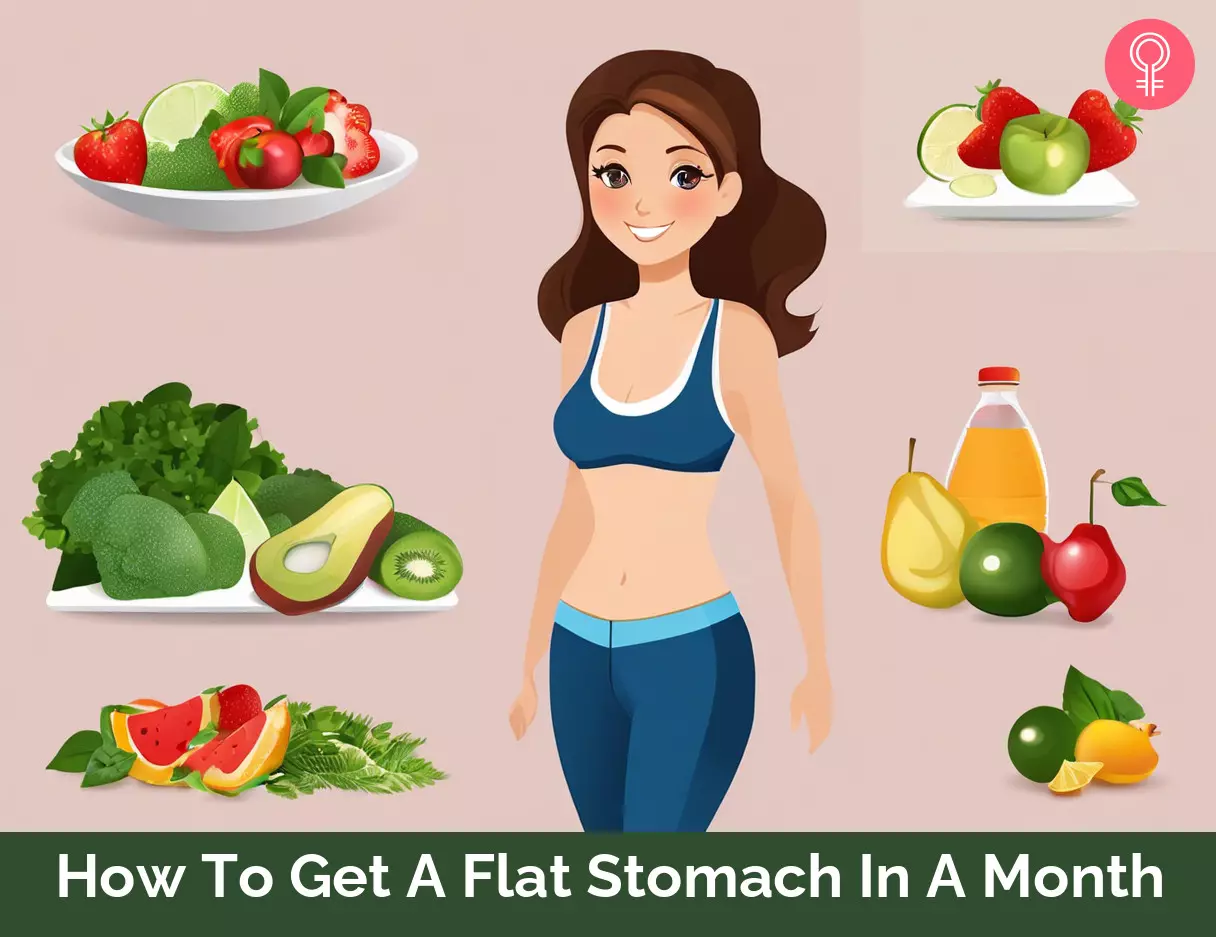
Image: Stable Diffusion/StyleCraze Design Team
Fed up with stubborn belly fat? Discover effective techniques to permanently eliminate it within a span of 4 weeks! Check out the informative video below for step-by-step guidance for achieving a slimmer waistline.
Personal Experience: Source
StyleCraze's articles are interwoven with authentic personal narratives that provide depth and resonance to our content. Below are the sources of the personal accounts referenced in this article.
i. I Lost Over 100 Pounds and My Outside Matches My Insidehttps://medium.com/in-fitness-and-in-health/i-lost-over-100-pounds-and-my-outside-matches-my-inside-85d61c19285e
References
Articles on StyleCraze are backed by verified information from peer-reviewed and academic research papers, reputed organizations, research institutions, and medical associations to ensure accuracy and relevance. Read our editorial policy to learn more.
- Association of Changes in Abdominal Fat Quantity and Quality With Incident Cardiovascular Disease Risk Factors, Journal of the American College of Cardiology, US National Library of Medicine, National Institutes of Health.
https://www.ncbi.nlm.nih.gov/pmc/articles/PMC5599249/ - How strong is the association between abdominal obesity and the incidence of type 2 diabetes? International Journal of Clinical Practice, US National Library of Medicine, National Institutes of Health.
https://www.ncbi.nlm.nih.gov/pmc/articles/PMC2658023/ - Intra-abdominal fat accumulation is a hypertension risk factor in young adulthood, Medicine, US National Library of Medicine, National Institutes of Health.
https://www.ncbi.nlm.nih.gov/pmc/articles/PMC5106067/ - Determinants of body fat distribution in humans may provide insight about obesity-related health risks, Journal of Lipid Research, US National Library of Medicine, National Institutes of Health.
https://pubmed.ncbi.nlm.nih.gov/30097511-determinants-of-body-fat-distribution-in-humans-may-provide-insight-about-obesity-related-health-risks/ - Body fat distribution, in particular visceral fat, is associated with cardiometabolic risk factors in obese women, PLoS One, US National Library of Medicine, National Institutes of Health.
https://www.ncbi.nlm.nih.gov/pmc/articles/PMC5619737/ - Factors That Influence Body Weight, Weight Management: State of the Science and Opportunities for Military Programs, US National Library of Medicine, National Institutes of Health.
https://www.ncbi.nlm.nih.gov/books/NBK221834/ - Effectiveness of a low-calorie weight loss program in moderately and severely obese patients, Obesity Facts, US National Library of Medicine, National Institutes of Health.
https://pubmed.ncbi.nlm.nih.gov/24135973-effectiveness-of-a-low-calorie-weight-loss-program-in-moderately-and-severely-obese-patients/ - Comparison of two low-calorie diets: a prospective study of effectiveness and safety, Journal of Endocrinological Investigation, US National Library of Medicine, National Institutes of Health.
https://pubmed.ncbi.nlm.nih.gov/16957412-comparison-of-two-low-calorie-diets-a-prospective-study-of-effectiveness-and-safety/ - The sweet danger of added sugars, European Journal of Paediatric Dentistry, US National Library of Medicine, National Institutes of Health.
https://pubmed.ncbi.nlm.nih.gov/31246081-the-sweet-danger-of-added-sugars/ - Consumption of Sugars, Sugary Foods, and Sugary Beverages in Relation to Cancer Risk: A Systematic Review of Longitudinal Studies, Annual Review of Nutrition, US National Library of Medicine, National Institutes of Health.
https://pubmed.ncbi.nlm.nih.gov/29801420-consumption-of-sugars-sugary-foods-and-sugary-beverages-in-relation-to-cancer-risk-a-systematic-review-of-longitudinal-studies/ - Dietary fiber and body weight, Nutrition, US National Library of Medicine, National Institutes of Health.
https://pubmed.ncbi.nlm.nih.gov/15797686-dietary-fiber-and-body-weight/ - The effect of fiber on satiety and food intake: a systematic review, Journal of the American College of Nutrition, US National Library of Medicine, National Institutes of Health.
https://pubmed.ncbi.nlm.nih.gov/23885994/ - Fiber and Prebiotics: Mechanisms and Health Benefits, Nutrients, MDPI.
https://www.mdpi.com/2072-6643/5/4/1417 - Effect of a High-Protein Diet versus Standard-Protein Diet on Weight Loss and Biomarkers of Metabolic Syndrome: A Randomized Clinical Trial, Obes Facts, US National Library of Medicine, National Institutes of Health.
https://www.ncbi.nlm.nih.gov/pmc/articles/PMC5644969/ - The role of protein in weight loss and maintenance, The American Journal of Clinical Nutrition, US National Library of Medicine, National Institutes of Health.
https://pubmed.ncbi.nlm.nih.gov/25926512-the-role-of-protein-in-weight-loss-and-maintenance/ - A High-Protein Diet Reduces Weight Gain, Decreases Food Intake, Decreases Liver Fat Deposition, and Improves Markers of Muscle Metabolism in Obese Zucker Rats, Nutrients, US National Library of Medicine, National Institutes of Health.
https://www.ncbi.nlm.nih.gov/pmc/articles/PMC5490566/ - A whey-protein supplement increases fat loss and spares lean muscle in obese subjects: a randomized human clinical study, US National Library of Medicine, National Institutes of Health.
https://www.ncbi.nlm.nih.gov/pmc/articles/PMC2289832/ - Influence of Water Intake and Balance on Body Composition in Healthy Young Adults from Spain, Nutrients, US National Library of Medicine, National Institutes of Health.
https://www.ncbi.nlm.nih.gov/pmc/articles/PMC6723835/ - Increased Hydration Can Be Associated with Weight Loss, Frontiers in Nutrition, US National Library of Medicine, National Institutes of Health.
https://pubmed.ncbi.nlm.nih.gov/27376070-increased-hydration-can-be-associated-with-weight-loss/ - Inadequate Hydration, BMI, and Obesity Among US Adults: NHANES 2009-2012, Annals of Family Medicine, US National Library of Medicine, National Institutes of Health.
https://www.ncbi.nlm.nih.gov/pmc/articles/PMC4940461/ - Omega-3 fatty acids and inflammation, Current Atherosclerosis Reports, US National Library of Medicine, National Institutes of Health.
https://pubmed.ncbi.nlm.nih.gov/15485592-omega-3-fatty-acids-and-inflammation/ - An Increase in the Omega-6/Omega-3 Fatty Acid Ratio Increases the Risk for Obesity, Nutrients, US National Library of Medicine, National Institutes of Health.
https://www.ncbi.nlm.nih.gov/pmc/articles/PMC4808858/ - Efficacy of tea catechin-rich beverages to reduce abdominal adiposity and metabolic syndrome risks in obese and overweight subjects: a pooled analysis of 6 human trials.” Nutrition Research (New York, N.Y.), US National Library of Medicine, National Institutes of Health.
https://pubmed.ncbi.nlm.nih.gov/29914623-efficacy-of-tea-catechin-rich-beverages-to-reduce-abdominal-adiposity-and-metabolic-syndrome-risks-in-obese-and-overweight-subjects-a-pooled-analysis-of-6-human-trials/ - Beneficial Effects of Tea and the Green Tea Catechin Epigallocatechin-3-gallate on Obesity, Molecules, US National Library of Medicine, National Institutes of Health.
https://www.ncbi.nlm.nih.gov/pmc/articles/PMC6274011/ - Beneficial Properties of Probiotics, Tropical Life Sciences Research, US National Library of Medicine, National Institutes of Health.
https://www.ncbi.nlm.nih.gov/pmc/articles/PMC5031164/ - Probiotics: How Effective Are They in the Fight against Obesity? Nutrients, US National Library of Medicine, National Institutes of Health.
https://www.ncbi.nlm.nih.gov/pmc/articles/PMC6412733/ - Sodium, Advances in Nutrition, US National Library of Medicine, National Institutes of Health.
https://www.ncbi.nlm.nih.gov/pmc/articles/PMC3951800/ - “Salt”, CDC
https://www.cdc.gov/salt/about/index.html - The Effectiveness of Intermittent Fasting to Reduce Body Mass Index and Glucose Metabolism: A Systematic Review and Meta-Analysis, Journal of Clinical Medicine, US National Library of Medicine, National Institutes of Health.
https://pubmed.ncbi.nlm.nih.gov/31601019-the-effectiveness-of-intermittent-fasting-to-reduce-body-mass-index-and-glucose-metabolism-a-systematic-review-and-meta-analysis/ - Clinical Management of Intermittent Fasting in Patients with Diabetes Mellitus, Nutrients, US National Library of Medicine, National Institutes of Health.
https://www.ncbi.nlm.nih.gov/pmc/articles/PMC6521152/ - The role of exercise and physical activity in weight loss and maintenance, Progress in Cardiovascular Diseases, US National Library of Medicine, National Institutes of Health.
https://www.ncbi.nlm.nih.gov/pmc/articles/PMC3925973/ - Evidence for Resistance Training as a Treatment Therapy in Obesity, Journal of Obesity, US National Library of Medicine, National Institutes of Health.
https://www.ncbi.nlm.nih.gov/pmc/articles/PMC2931407/ - High-Intensity Interval Training in the Real World: Outcomes from a 12-Month Intervention in Overweight Adults, Medicine and Science in Sports and Exercise, US National Library of Medicine, National Institutes of Health.
https://pubmed.ncbi.nlm.nih.gov/29683919-high-intensity-interval-training-in-the-real-world-outcomes-from-a-12-month-intervention-in-overweight-adults/ - Excess Postexercise Oxygen Consumption After High-Intensity and Sprint Interval Exercise, and Continuous Steady-State Exercise, Journal of Strength and Conditioning Research, US National Library of Medicine, National Institutes of Health.
https://pubmed.ncbi.nlm.nih.gov/26950358-excess-postexercise-oxygen-consumption-after-high-intensity-and-sprint-interval-exercise-and-continuous-steady-state-exercise/ - Is interval training the magic bullet for fat loss? A systematic review and meta-analysis comparing moderate-intensity continuous training with high-intensity interval training (HIIT), British Journal of Sports Medicine, US National Library of Medicine, National Institutes of Health.
https://pubmed.ncbi.nlm.nih.gov/30765340-is-interval-training-the-magic-bullet-for-fat-loss-a-systematic-review-and-meta-analysis-comparing-moderate-intensity-continuous-training-with-high-intensity-interval-training-hiit/ - Resistance Training Prevents Muscle Loss Induced by Caloric Restriction in Obese Elderly Individuals: A Systematic Review and Meta-Analysis, Nutrients, US National Library of Medicine, National Institutes of Health.
https://www.ncbi.nlm.nih.gov/pmc/articles/PMC5946208/ - Resistance Training Combined With Diet Decreases Body Fat While Preserving Lean Mass Independent of Resting Metabolic Rate: A Randomized Trial, International Journal of Sport Nutrition and Exercise Metabolism, US National Library of Medicine, National Institutes of Health.
https://pubmed.ncbi.nlm.nih.gov/28871849-resistance-training-combined-with-diet-decreases-body-fat-while-preserving-lean-mass-independent-of-resting-metabolic-rate-a-randomized-trial/ - Stress and Obesity: Are There More Susceptible Individuals? Current Obesity Reports, US National Library of Medicine, National Institutes of Health.
https://www.ncbi.nlm.nih.gov/pmc/articles/PMC5958156/ - Stress and abdominal Fat: Preliminary Evidence of Moderation by the Cortisol awakening Response in Hispanic Peripubertal Girls, Obesity, US National Library of Medicine, National Institutes of Health.
https://www.ncbi.nlm.nih.gov/pmc/articles/PMC3107005/ - Sleep and metabolism: an overview, International Journal of Endocrinology, US National Library of Medicine, National Institutes of Health.
https://www.ncbi.nlm.nih.gov/pmc/articles/PMC2929498/ - Sleep disturbances, body fat distribution, food intake and/or energy expenditure: pathophysiological aspects, Hormone Molecular Biology and Clinical Investigation, US National Library of Medicine, National Institutes of Health.
https://www.ncbi.nlm.nih.gov/pmc/articles/PMC4410731/ - The impact of sleep disturbances on adipocyte function and lipid metabolism, Best Practice & Research. Clinical Endocrinology & Metabolism, US National Library of Medicine, National Institutes of Health.
https://www.ncbi.nlm.nih.gov/pmc/articles/PMC3031100/ - Sleep Duration and Five-Year Abdominal Fat Accumulation in a Minority Cohort:The IRAS Family Study, Sleep, US National Library of Medicine, National Institutes of Health.
https://www.ncbi.nlm.nih.gov/pmc/articles/PMC2831422/# - Melatonin, the Hormone of Darkness: From Sleep Promotion to Ebola Treatment, Brain Disorders & Therapy, US National Library of Medicine, National Institutes of Health.
https://www.ncbi.nlm.nih.gov/pmc/articles/PMC4334454/
Read full bio of Garima Singh
- Jordan Anthony is a Registered Dietitian Nutritionist with over 6 years of experience. She was a public relations professional before she went back to the University of Southern California to get a Master's degree in Nutrition, Healthspan and Longevity. She is currently serving as the Senior Director of Nutrition at Ahara Corporation in Los Angeles, USA.
 Jordan Anthony is a Registered Dietitian Nutritionist with over 6 years of experience. She was a public relations professional before she went back to the University of Southern California to get a Master's degree in Nutrition, Healthspan and Longevity. She is currently serving as the Senior Director of Nutrition at Ahara Corporation in Los Angeles, USA.
Jordan Anthony is a Registered Dietitian Nutritionist with over 6 years of experience. She was a public relations professional before she went back to the University of Southern California to get a Master's degree in Nutrition, Healthspan and Longevity. She is currently serving as the Senior Director of Nutrition at Ahara Corporation in Los Angeles, USA.
Read full bio of Ravi Teja Tadimalla
Read full bio of Payal Karnik






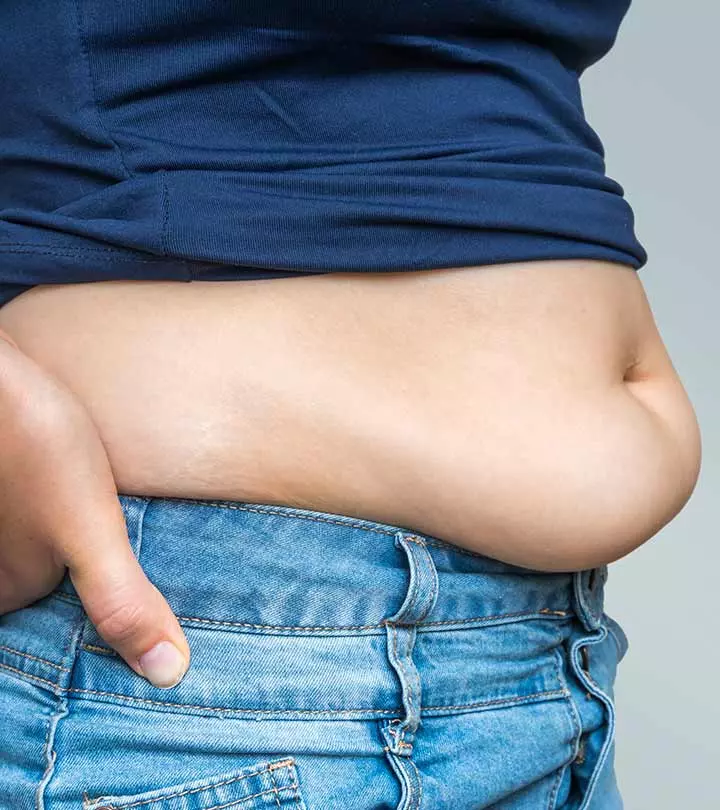







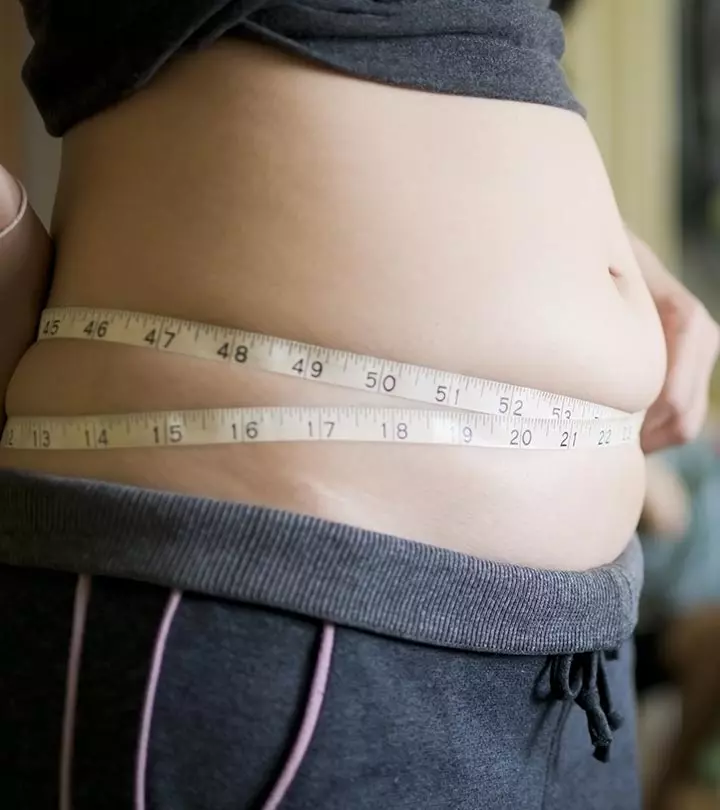






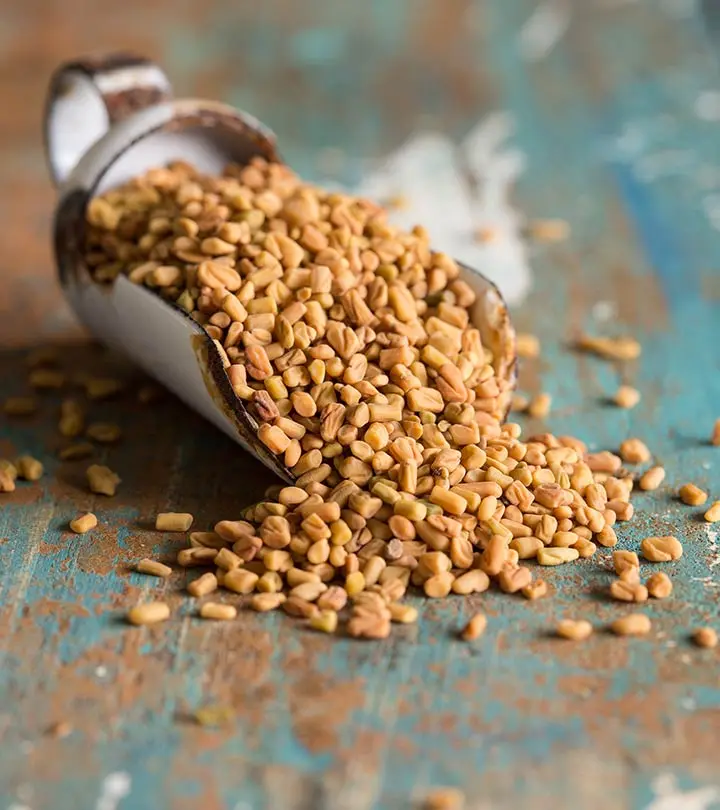



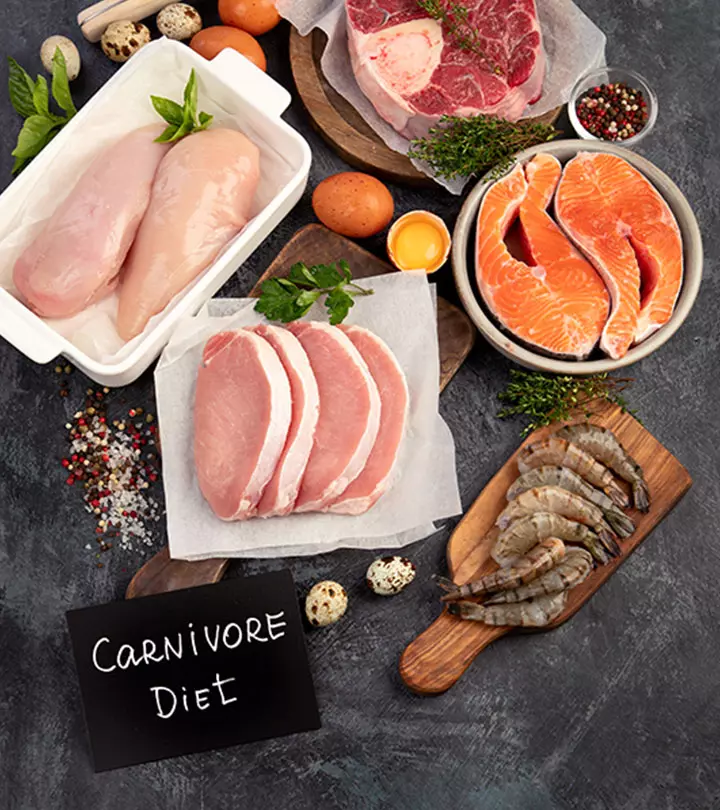
Community Experiences
Join the conversation and become a part of our empowering community! Share your stories, experiences, and insights to connect with other beauty, lifestyle, and health enthusiasts.